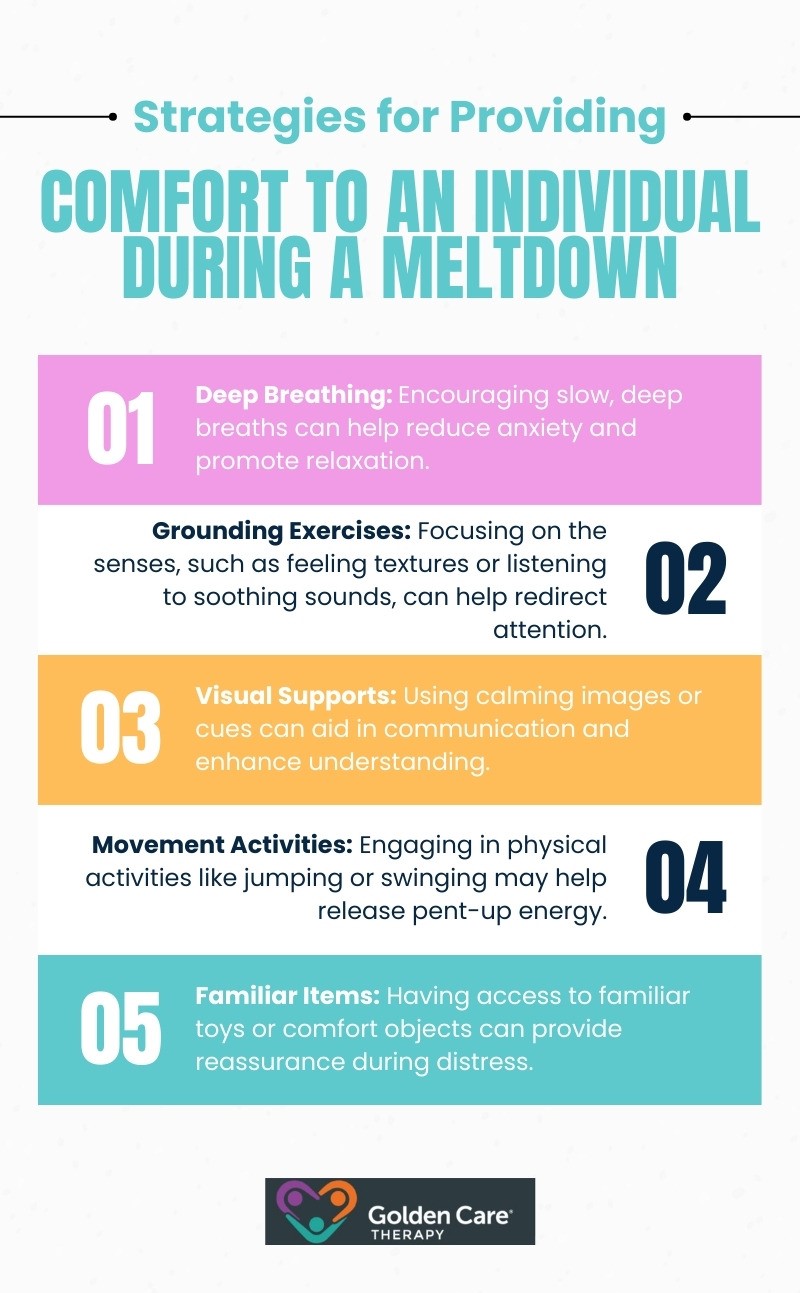Understanding common triggers can help caregivers better support individuals with autism. Meltdowns and shutdowns are both responses to overwhelming sensory experiences or emotional stress.
Recognizing these triggers can be essential in distinguishing between a meltdown and a shutdown, as both require different coping strategies and support mechanisms. Understanding sensory processing and common triggers helps parents and caregivers prepare and respond appropriately to the needs of individuals with autism.
Differentiating Between Meltdowns and Shutdowns
Understanding the difference between meltdowns and shutdowns is essential for parents and caregivers. Both reactions can occur due to sensory overload, but they manifest in distinct ways.
Meltdowns are intense emotional outbursts that typically result from overwhelming sensory input or frustration. They can be loud and disruptive, often characterized by visible signs of distress.
Shutdowns, on the other hand, are responses to overwhelming experiences but are characterized by a withdrawal from the environment. During a shutdown, an individual may become quiet and unresponsive.
Recognizing the differences between these two responses helps parents and caregivers better support individuals with autism in managing their sensory problems.
Support Strategies for Meltdowns
Meltdowns can be overwhelming for individuals with autism and those around them. Implementing effective support strategies is crucial in these situations. This section will discuss calming techniques during a meltdown and how to create a safe environment.
During a meltdown, certain calming techniques can help mitigate the intensity of the situation. These strategies focus on providing comfort and reassurance to the individual. Such strategies include the following:

Aside from that, establishing a safe space is also vital for individuals experiencing a meltdown. A supportive environment can help reduce sensory overload and promote calmness.
Here are some techniques to achieve that:
- Designate a noise-free zone to give the individual a break from overwhelming sounds.
- Use dim or soft lighting to create a soothing atmosphere that is less likely to trigger further agitation.
- Reduce visual clutter and electronics to help the individual focus and feel less overwhelmed.
- Incorporate soft blankets or pillows to provide tactile comfort during a meltdown.
- Set clear physical and emotional boundaries to help the individual feel secure.
Employing these calming techniques and ensuring a safe environment makes it so that parents and caregivers can better support individuals during meltdowns. This proactive approach can create a compassionate space conducive to emotional regulation.
Coping Strategies for Shutdowns
Once an autistic individual experiences shutdowns, it is essential to provide support and encouragement to help them manage their sensory overload. Understanding specific strategies can facilitate better coping during these challenging moments.
During a shutdown, caregivers and parents have to approach the situation with sensitivity and understanding. Here are some helpful strategies:
- Maintain a Low-Stimulation Environment: Reduce noise, bright lights, and crowds to create a more calming atmosphere.
- Provide a Safe Space: Designate a quiet area where the individual can retreat to feel secure and comfortable.
- Use Comfort Items: Offer familiar objects (e.g., a favorite blanket or toy) that bring comfort during distress.
- Offer Gentle Reassurance: Calmly remind the individual that they are safe and that it is okay to take time to regroup.
Moreover, teaching self-regulation skills can empower individuals to manage shutdowns more effectively. Implementing the following techniques can assist in developing these skills:
- Introduce deep breathing techniques to help individuals calm their minds and bodies.
- Use visual schedules or charts to provide structure and clarity in their daily routines.
- Encourage individuals to express their feelings and experiences in a journal to promote self-awareness.
- Engage in simple mindfulness activities, such as meditation or listening to soothing music, to enhance emotional regulation.
Through the help of these strategies and techniques, caregivers and parents can help individuals navigate shutdowns more effectively. Understanding the signs of meltdowns vs. shutdown in children with autism can lead to better support and tailored interventions.

Tips for Building a Supportive Environment
Creating a supportive environment is another essential strategy for managing sensory challenges associated with autism. This involves both individualized planning and the promotion of spaces conducive to sensory needs.
Individualized plans are tailored strategies that consider the unique needs, preferences, and triggers of each individual with autism. These plans can help in effectively managing both meltdowns and shutdowns.
Developing these plans in collaboration with the individual, caregivers, and professionals can enhance the effectiveness of the strategies in place.
Meanwhile, sensory-friendly spaces play a crucial role in creating an environment where individuals with autism can feel safe and comfortable. These spaces should minimize sensory overload and provide opportunities for relaxation and self-regulation.
Implementing these features can help individuals with autism feel more at ease and better equipped to manage their sensory issues. Creating an environment that supports individual needs contributes significantly to their overall well-being.
When to Seek Professional Help
While navigating the complexities of autism, especially concerning sensory issues like meltdowns and shutdowns, obtaining professional support can be invaluable. It offers strategies tailored to individual needs and alleviates the challenges faced by both caregivers and individuals with autism.
Engaging with therapists or specialists can provide insights and strategies to manage sensory challenges effectively. Professionals may focus on understanding the specific triggers for meltdowns and shutdowns, which allows for the development of personalized coping strategies.
A variety of therapy options can be explored to develop effective coping mechanisms for meltdowns and shutdowns. Each option may be tailored to meet the unique needs of the individual.
Here are some common therapy options that may be beneficial:
- Cognitive behavioral therapy
- Play therapy
- Mindfulness and relaxation techniques
- Sensory integration therapy
Exploring these options with qualified professionals can empower individuals and caregivers to effectively cope with the sensory demands associated with autism. By finding the right support and therapies, they can navigate meltdowns and shutdowns more successfully.
The Bottom Line
Recognizing the difference between a meltdown and a shutdown in children with autism makes it easier to offer the right kind of support.
A meltdown is an intense reaction that comes from overwhelming emotions, while a shutdown is a retreat into silence and withdrawal when everything feels too much. Both are ways a child communicates distress, and neither is a choice or bad behavior. Understanding their needs, providing comfort, and creating a calm environment can make a big difference.
With patience and the right approach, children can feel safe, supported, and better equipped to navigate overwhelming moments. At Golden Care Therapy, we provide high-quality ABA therapy in New Jersey, Indiana, New York, Georgia, and Florida, tailoring our services to meet each child’s unique needs.
We have a dedicated team that uses evidence-based strategies to foster meaningful progress and build essential life skills. Contact us today to learn how we can support your child’s journey with compassionate, expert care!
Sources:



